
Introduction
Brining chicken can make a significant difference in how your meals taste and feel, and using a simple chicken brine can help ensure your chicken stays moist, flavorful, and tender every time. If you’ve ever had a dry piece of chicken that you couldn’t chew through, brining is your solution. The process of brining not only enhances the flavor of the meat but also works wonders in improving its texture, ensuring that every bite is succulent and delicious. Imagine biting into a perfectly cooked piece of chicken that is not only bursting with flavor but also incredibly juicy.
That’s the magic of brining! By soaking the chicken in a seasoned saltwater solution, you allow the meat to absorb moisture and flavors that can transform even the most basic chicken dish into a culinary delight. In this guide, we’ll take a closer look at what brining is and how it works.
We’ll explore the science behind the process, highlighting how it affects the proteins in the meat and leads to a more tender texture. Additionally, we’ll discuss the numerous benefits that brining offers, such as enhanced flavor profiles, improved moisture retention, and versatility in cooking methods. Whether you’re a novice cook looking to elevate your meals or a seasoned chef seeking new techniques, brining is a simple yet effective method that can easily be incorporated into your cooking routine. You don’t need any special equipment or ingredients—just some salt, water, and a little time.
So grab your apron and let’s dive in! With our step-by-step instructions, tips for success, and creative flavor ideas, you’ll soon be brining chicken like a pro and impressing everyone at your dinner table. Prepare to discover a new world of flavors and textures that will make your chicken dishes unforgettable!
1. Understanding Simple Chicken Brine
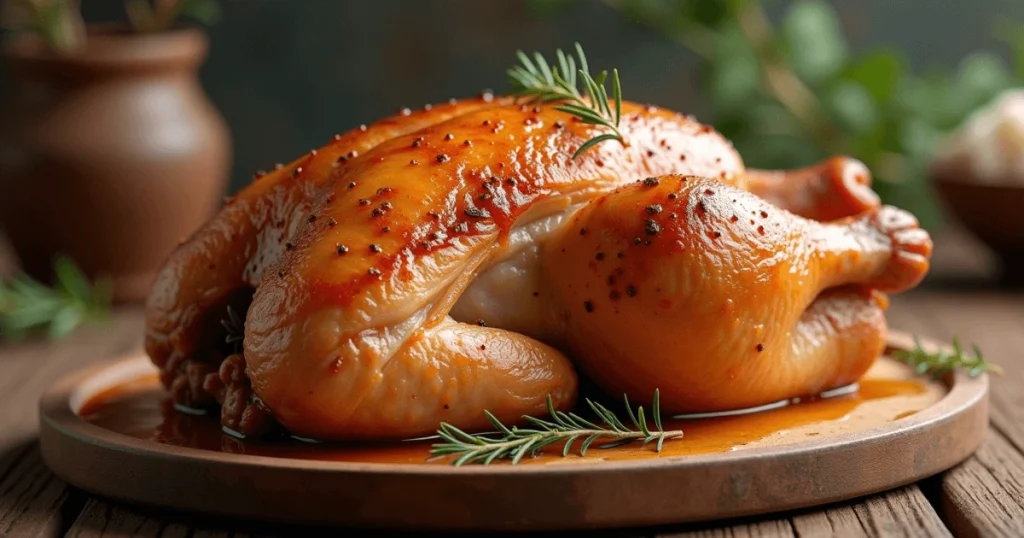
1.1 What is Brining?
Brining is the process of soaking chicken in a special solution of salt and water (and often other flavorings) before cooking.
- The science behind brining: When simple chicken brine is immersed in this salty solution, the salt does magical things. It works its way into the meat, breaking down proteins and allowing the chicken to absorb water. This process makes the final product juicier and more flavorful.
- Historical uses of brine: People have been salting and preserving food for centuries, from ancient Egyptians to modern-day chefs. Brining was invented to help preserve meats long before refrigeration existed.
- Differences between brining and marinating: While both processes involve soaking meat in a solution, brining is focused primarily on moisture retention and flavor enhancement through salt. Marinades usually add more complex flavors with acidic components.
1.2 Benefits of Brining Chicken
Brining brings several benefits to your cooking.
- Enhancing flavor and juiciness: When simple chicken brine is brined, it absorbs extra moisture and seasoning, giving it a much richer flavor. Imagine biting into a succulent, flavorful piece of chicken—heaven!
- Improving texture and tenderness: The science of brining softens the proteins in the chicken, resulting in a tender texture that’s almost impossible to achieve without this step.
- Reducing cooking time and increasing moisture retention: simple chicken brine cooks faster because the moisture it has absorbed helps it get to the desired temperature quickly without drying out.
1.3 When to Use Brine
Brining isn’t just a one-size-fits-all solution; knowing when and how to use it is key.
- Best practices for different chicken cuts: Whole chickens, breasts, and thighs all benefit from brining, but the time needed can vary. Larger cuts require longer soaking times.
- Ideal scenarios for brining: Brining really shines when grilling or roasting chicken, as these methods can easily dry meat out.
- Considerations for timing and duration: A good rule of thumb is to simple chicken brine for 1 hour per pound, but you can go up to 24 hours for larger cuts without adverse effects.
2. Basic Brine Recipe
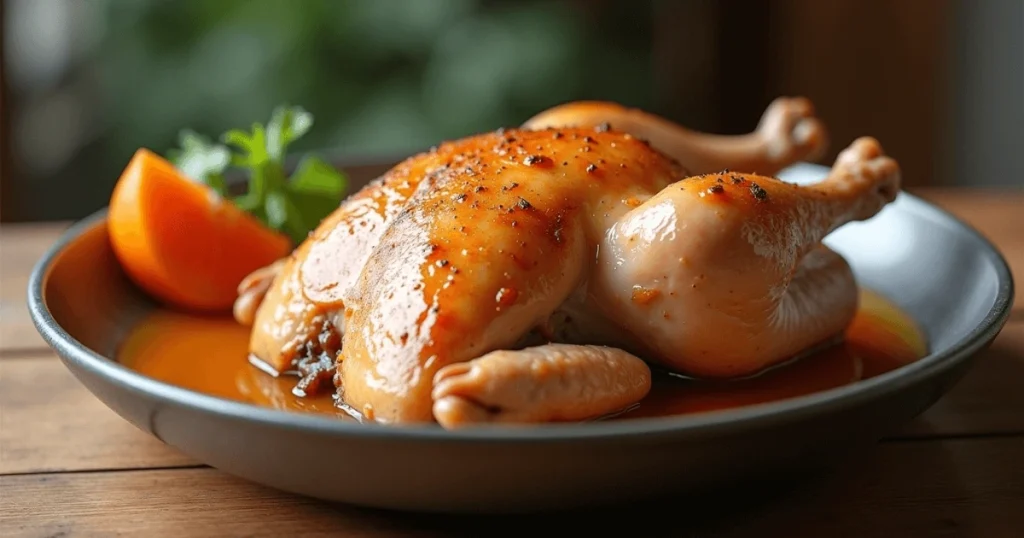
2.1 Essential Ingredients
A simple brine recipe is all you need to get started.
- Types of salt and their impact: You can use kosher salt, sea salt, or table salt. Kosher salt is preferred as it dissolves easily and doesn’t contain any additives that other salts may have.
- Optional flavor enhancers: Adding sugar can balance out the saltiness, while herbs and spices like garlic, bay leaves, or peppercorns can elevate the flavor.
- The role of water quality in brining: Use filtered or bottled water if possible. The better the quality of water, the better the outcome of your brine.
2.2 Step-by-Step Guide to Making a Simple Brine
Creating a basic brine is straightforward.
- Exact measurements for a basic brine: A common ratio is 1 cup of kosher salt and 1 cup of sugar dissolved in 1 gallon of water.
- Recommended equipment for brining: Use a large container or a resealable plastic bag—something that can keep the brine in contact with the chicken while it soaks.
- Safety tips for preparation: Always keep the brine and chicken in the fridge during the brining process to avoid any food safety issues.
2.3 Variations on the Basic Brine
Try these variations to switch things up.
- Sweet brine options: Incorporate honey or maple syrup for a hint of sweetness that pairs beautifully with savory dishes.
- Savory brine options: Adding garlic and onion to the mix will impart wonderful flavors right into the chicken.
- Regional twists: Consider Cajun spices for a Southern twist or classic Mediterranean herbs for something fresher.
3. How to Brine Chicken
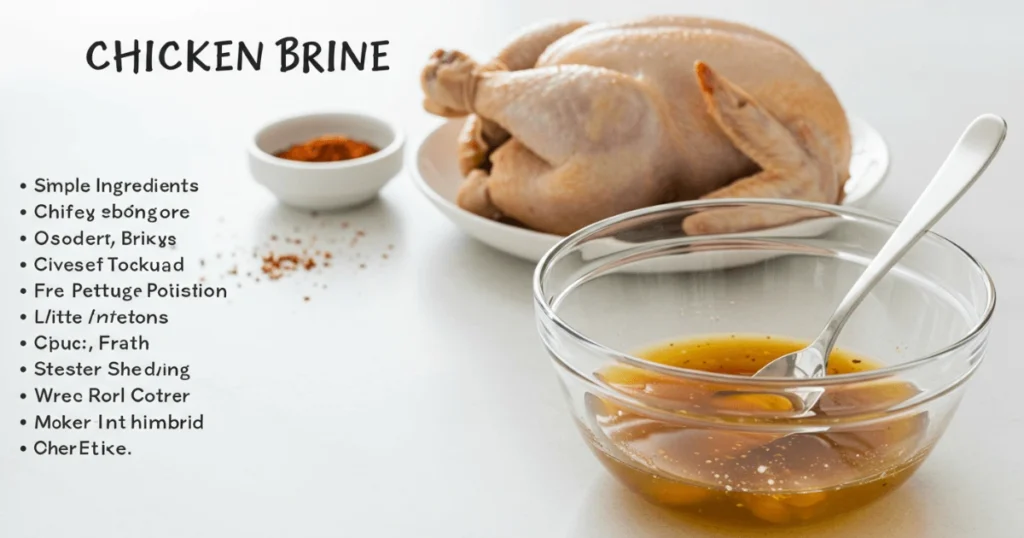
3.1 Preparing the Chicken
Getting your chicken ready is the first step to success.
- Choosing the right cut for brining: Thighs, breasts, and wings are great candidates. Just ensure they are fresh or completely thawed.
- Cleaning and prepping chicken: Rinse the chicken under cold running water and pat dry before brining to remove any impurities.
- Tips for puncturing the meat: Use a fork to poke several holes in the chicken to help the brine penetrate better.
3.2 Brining Technique
The right technique will yield the best results.
- Proper container selection: A non-reactive container (glass, stainless steel, or food-safe plastic) is best for brining.
- Ideal temperatures for brining: The chicken should ideally be kept at 32°F to 40°F in the fridge during brining.
- Monitoring time for effectiveness: Keep an eye on the clock; over-brining can lead to overly salty chicken.
3.3 Rinsing and Drying
After brining, there’s a bit more to do.
- Importance of rinsing after brining: Rinse the chicken under cold water to wash away excess brine that could lead to over-salting.
- Best drying techniques: Pat the chicken dry with paper towels to ensure a nice sear when cooking.
- How drying affects the cooking process: Dry chicken can achieve a crispy skin, while moisture-rich chicken will stay juicy throughout cooking.
4. Cooking Simple Chicken Brine
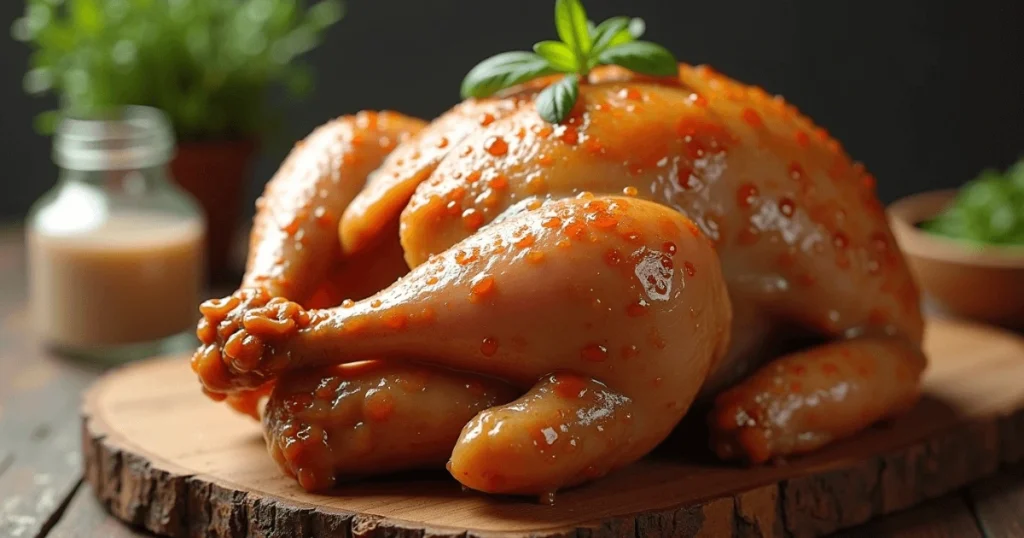
4.1 Best Cooking Methods
You can cook brined chicken in a variety of ways.
- Grilling brined chicken: The high heat of the grill requires a careful approach, so keep an eye on the temperature.
- Roasting methods for brined chicken: Oven-roasting at moderate heat allows the flavors to develop nicely.
- Other cooking methods: Don’t shy away from frying, steaming, or slow-cooking; each technique offers a chance to showcase the brined flavor.
4.2 Timing and Temperature Guidelines
Proper cooking is crucial for safety and flavor.
- Internal temperatures for safety: Chicken should reach an internal temperature of 165°F for safe consumption.
- Cooking times for different cuts: Breasts typically cook faster than thighs, so refer to a cooking chart or timing guide for specifics.
- Adjusting recipes for brined chicken: You may need to reduce the amount of added salt in your recipes since brined chicken is already seasoned.
4.3 Pairing Side Dishes
Great chicken deserves great sides!
- Recommended sides that complement brined chicken: Consider fresh salads, roasted vegetables, or creamy mashed potatoes to balance the meal.
- Creating a balanced meal: Pair protein with fiber-rich veggies and carbohydrates for a well-rounded plate.
- Tips on enhancing flavors: Think about homemade sauces or dressings that will enhance—not overpower—your delicious brined chicken.
5. Troubleshooting Common Brining Issues
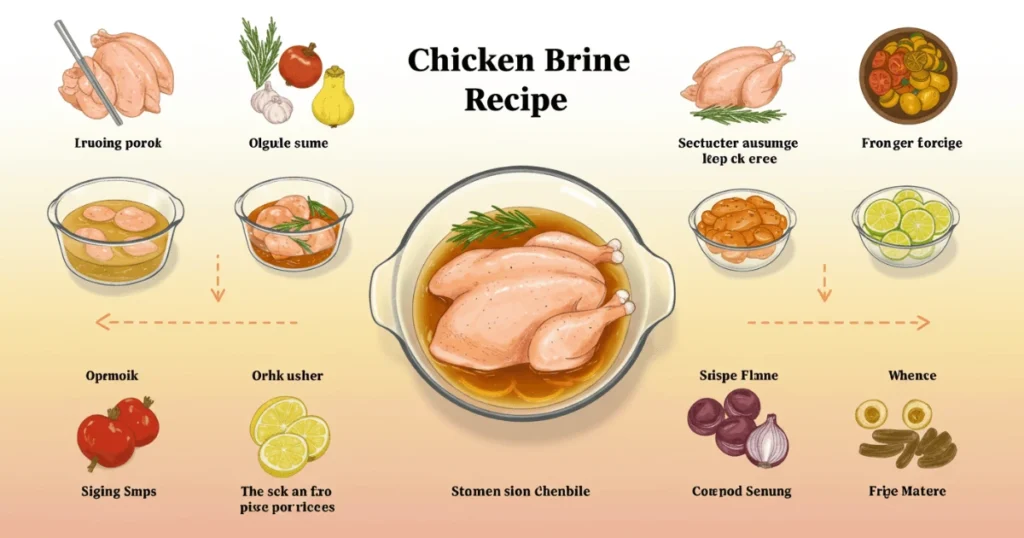
5.1 Over-Brining Effects
Sometimes things can go a bit wrong.
- Signs of over-brining and how to avoid it: Your chicken might be too salty or mushy; keep a close watch on soaking times.
- Restoring balance in over-brined chicken: A quick rinse can help, or you can balance it with low-sodium dishes.
- Lessons learned from brining mishaps: Everyone forgets timing once in a while—just be sure to take notes for next time!
5.2 Under-Brining Challenges
Not getting it just right can happen too.
- Recognizing under-brined chicken: If your simple chicken brine tastes flat or blah, it probably didn’t soak long enough.
- Correcting flavor deficiencies post-cooking: A good sauce can save an under-brined meal; consider a flavorful glaze or marinade.
- Techniques to salvage dry or flavorless chicken: Utilize broth or sauces to bring moisture back into your dish, and spice things up!
5.3 Customizing Brines for Allergies and Preferences
Don’t let dietary restrictions spoil the fun.
- Allergy-friendly brine ingredient swaps: Substitute salt with a more suitable seasoning option for those with health concerns.
- Vegetarian or vegan alternatives: Vegetable proteins can also benefit from a similar soaking technique—just adjust the soak time!
- Tips for low-sodium or health-conscious versions: Use less salt and increase the use of aromatic herbs and spices to keep the flavor profile intact.
Conclusion
simple chicken brine is an easy way to elevate your meals to restaurant quality. By experimenting with different brine recipes and flavors, you can find what works best for your tastes. So, roll up your sleeves, gather your ingredients, and start your brining adventure—your taste buds will thank you!
FAQs
How long can I brine chicken? A general rule is 1 hour per pound. Larger cuts can soak for up to 24 hours.
Can I reuse brine for multiple batches? It’s best to discard used brine to avoid any risk of contamination. Always start fresh!
What should I do if I don’t have salt? You can create a flavoring solution with herbs and spices, but salt is vital for the brining process.
Is brining necessary for all chicken dishes? Not every dish requires brining, but it makes a world of difference for grilling or roasting.
Can I brine frozen chicken, and how does that work? Yes! Just allow the chicken to thaw in the brine, and it can absorb the flavor as it defrosts.
Share Your Experience
There are no reviews yet. Be the first one to write one.

3 Comments
Comments are closed.